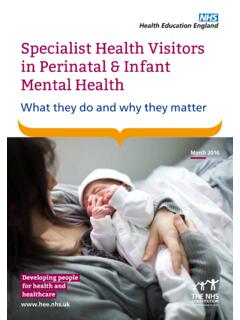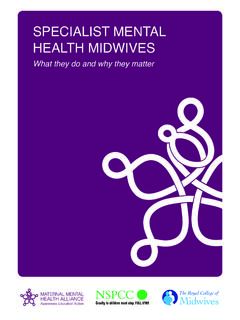Transcription of Guidelines for Routine Prenatal Care
1 APEC Guidelines for Routine Prenatal care Introduction Routine Prenatal care labs and screening tests should be performed throughout pregnancy on all women to identify risk factors and initiate preventive care measures. Maintaining maternal health optimizes the success for positive pregnancy outcomes. Screening, treatment and documentation requirements per trimester are listed below. (AAP/ACOG, 2012; Platt, 2010). Initial visit The initial visit optimally should occur in the first trimester. The following screening should be performed regardless of the gestational age at the initial visit: 1. Laboratory screening includes: Blood type and Rh factor with antibody screening to identify isoimmunization. Patients found to be Rh negative should be rescreened in the second trimester and given RhoGAM at 28 weeks and again after delivery, if the infant is Rh positive. Hct or Hgb Blood volume in pregnancy increases more than red cell volume and hematocrit typically falls.
2 Therefore Hct or Hgb levels should be monitored for signs of anemia. Anemia is often caused by iron-deficiency and should be treated with supplemental iron, taken in addition to Routine Prenatal vitamins. A normal term pregnancy requires approximately 1gm of iron, an amount not adequately supplied in the diet. Rubella to determine if the mother is susceptible or immune. If susceptible, she should receive vaccination postpartum . Varicella to determine if the mother is susceptible or immune. If susceptible, she should receive vaccination postpartum . VDRL or RPR to check for serologic evidence syphilis so treatment can be initiated as soon as possible to avoid vertical transmission and the sequelae of congenital syphilis. Gonorrhea and Chlamydia tests to identify and treat infection. Urine culture to identify and treat urinary tract infection, including asymptomatic bacteriuria which is associated with a 25% risk of pyelonephritis if left untreated.
3 Hepatitis B surface antigen to identify women whose infants need immunoprophylaxis post -delivery to minimize the risk of congenital infection and carrier status Human immunodeficiency virus serology Antiretroviral therapy during gestation and around the time of delivery can decrease the risk of vertical transmission to less than 2%. HIV positive women should be counseled on the risks and benefits of treatment and mode of delivery. See APEC HIV guideline #18 for additional information. Pap Smear Women age 21- 29 years should have cytology screening every 3 years. Women age 30 65 years should have HPV & cytology co-screening every 5 years or cytology alone every 3 years. Women <21 years should not be screened. (ACOG, 2012. reaffirmed 2015). Discussion of Prenatal screening for chromosome abnormalities, genetic disease, and birth defects should be performed and documented in the patient's medical record. See APEC Prenatal Screening guideline #19 for additional information.
4 Topics to be addressed include: o Prenatal Screening and Diagnostic Tests for chromosome abnormalities . options include first trimester screening, quad screen, and Alabama perinatal Excellence Collaborative This document should not be construed as dictating an exclusive course of treatment or procedure to be followed. Guideline 1, version 7 Page 1 of 7 6/30/2015. APEC Guidelines for Routine Prenatal care integrated/sequential screening. AFP alone is NOT an acceptable screening strategy for chromosome abnormalities. o AFP for neural tube defect screening. o Cystic fibrosis carrier screening offered to Caucasians and discussed with other patients as they desire. o Hemoglobin electrophoresis for patients at risk of sickle cell trait, thalassemia, or other hemoglobinopathies includes African American patients, patients of Mediterranean or Asian ancestry (Sickle prep or sickle dex is inadequate because it only screens for hemoglobin S).
5 O Tay-Sachs, Canavan, and Familial Dysautonomia for patients of Eastern European Jewish ancestry. (ACOG, 2005 reaffirmed 2014). o TB skin test for patients at risk recent immigrants from developing countries, inmates, residents of mental institutions or group homes. 2. History and physical exam includes: Assessment of obstetric risk factors for adverse pregnancy outcomes including previous preterm birth, history of pre-eclampsia/eclampsia, history of gestational diabetes or macrosomic infant, previous C/S, history of IUGR infant. o Plans for assessment of risk in this pregnancy and risk reduction strategies should be documented. Smoking and substance abuse assessment and cessation counseling with follow up every trimester. o Nicotine replacement therapy and quitline referral can be considered. Immunization status and plan for vaccinations. See APEC Immunizations guideline #14. for additional information. Tdap at 27-36 wks Inactive Influenza vaccine-annual Family history of congenital defects or disorders.
6 Family planning counseling. Depression screening. (ACOG, 2010). Domestic violence screening. Discussion of weight gain recommendations:(ACOG, 2013b). o BMI < : 28-40 lbs o BMI : 25-35 lbs o BMI : 15-25 lbs o BMI >30: 11-20 lbs Discussion of feeding plans, breastfeeding experience and breast care 3. Ultrasound for establishment of intrauterine pregnancy and accurate pregnancy dating A first trimester crown-rump length measurement 13 weeks 6 days is the most accurate method to establish or confirm gestational age except for those conceived with advanced reproductive technologies. (ACOG, 2014) Early establishment of certain dating criteria is vital in later management decisions such as screening windows, preterm labor management, and delivery timing. Alabama perinatal Excellence Collaborative This document should not be construed as dictating an exclusive course of treatment or procedure to be followed. Guideline 1, version 7 Page 2 of 7 6/30/2015.
7 APEC Guidelines for Routine Prenatal care Subsequent Prenatal care Visits At each Prenatal care visit, Routine assessments include: weight, blood pressure, urine dipstick results including glucose, albumin and ketones; after 10 weeks documentation of fetal heart rate via auscultation or US (see below); and after 20 weeks, documentation of fetal movement and fundal height. Prenatal care visits should occur with the following frequency: o Prior to 20 weeks, ideally every 4 weeks but no less than every 6 weeks for lower-risk women. o 20 to 28 weeks, every 4 weeks. o 28 to 36 weeks, every 2-3 weeks, 3 weeks for lower-risk women. o 36 weeks to delivery, at least every week. Urine dipstick for protein, glucose, and ketones should be performed at all Prenatal visits. The lower socio-economic status of our Alabama Medicaid population is a risk factor for many adverse pregnancy outcomes thus, Routine urine dip testing during each Prenatal visit is recommended.
8 A baseline assessment of protein in the first trimester may play an important role in making a diagnosis in subsequent trimesters. In addition, early pregnancy glycosuria may be an indicator of maternal glucose intolerance and should trigger consideration of early screening for gestational diabetes. Fundal height measurements obtained after 20 weeks of gestation are a simple, effective screening test for fetal growth and amniotic fluid disturbances. When performed properly, the FH measurement in centimeters should approximate the gestational age in weeks. Guidelines for fundal height assessment: Measure from the symphysis pubis to the top of the fundus. Centimeter measurement should be within 3 weeks of gestational age. If measurements differ >3 cm, ultrasound for fetal growth and fluid should be performed if normal fluid and growth have not been documented within the last 4. weeks. In obese patients, assessment of fundal height is less reliable.
9 In many obese women, the fundus cannot be clearly identified. Even in those in whom the fundus is identifiable, the pannus may distort or interfere with accurate measurement. Although the evidence suggests that a trend of repeated measurements in obese women remains fairly sensitive in identifying growth disturbances, the reproducibility of the measurement, especially when performed by different providers, is lacking. Therefore, in obese patients for whom the fundus cannot be reliably palpated (usually women with BMI. >35), this should be documented in the Prenatal chart and an alternative plan for screening for growth abnormalities outlined. In general a reasonable alternative is serial ultrasounds for fetal growth every 4-6 weeks beginning at 26-28 weeks. Monitor maternal weight Query for contractions, leakage of fluid, and vaginal bleeding. Alabama perinatal Excellence Collaborative This document should not be construed as dictating an exclusive course of treatment or procedure to be followed.
10 Guideline 1, version 7 Page 3 of 7 6/30/2015. APEC Guidelines for Routine Prenatal care Second Trimester Assessments 1. Fetal Ultrasound Evaluations In general, all patients should have a fetal anatomic assessment performed at 17-20 weeks. While it is optimal to perform anatomy ultrasounds at an earlier GA, thus allowing the patient to maximize her reproductive options, the anatomy scans can occur between 17-22 weeks.. This time window optimizes the ability to accurately visualize fetal anatomy and provides adequate time for subspecialty consultation if abnormalities are visualized. In patients with risk factors for fetal abnormalities, subspecialty consultation should be considered for patient counseling and fetal anatomic assessment. If the initial anatomic assessment is normal, ultrasounds should be repeated only as clinically indicated. If an abnormality was visualized, the specific finding should dictate the need for further ultrasound evaluations.






